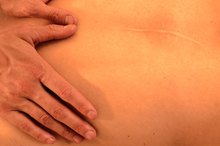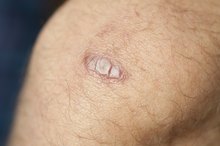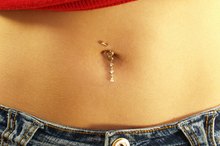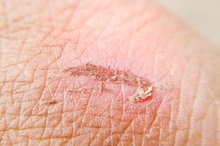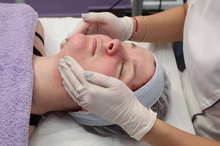How to Reduce Scar Tissue After Breast Implants
According to the Mayo Clinic, it isn't uncommon for some level of scarring to take place after breast augmentation 1. It may develop along the incision sites in the form of firm, pink scar tissue that later fades closer in tone with the rest of the skin. It may also develop around the breast implant itself in what is known as capsular contracture. Fortunately, there are things you can do to help reduce this scar tissue.
Talk to your cosmetic surgeon. Before trying any method for reducing scar tissue, discuss your options with a cosmetic surgeon. He may have a standard practice to minimize scar tissue after breast implants. Follow his recommendations whenever possible.
How to Apply Pressure for Keloid Scars
Learn More
Use a silicone-based bandage or sheeting. The American Academy of Dermatology says that silicone bandages and sheetings can actually reduce the thickness of scars. Daily use is necessary for best results. You can also find silicone in creams and gels that may provide similar effects on scar tissue.
Apply a cortisone cream. Creams containing cortisone can help soften scars, which may cause them to shrink in size. It's often necessary to allow the wounds to heal before applying this type of topical medication.
How to Reduce a Keloid
Learn More
Stock up on pressure bandages. According to the American Academy of Dermatology, pressure bandages can help to flatten scars. However, it can take several months of daily use to provide results.
Supplement your diet with vitamin E. Vitamin E supplements are said to reduce scar tissue that may form around the implant, asserts Dr. Joel Studin, a New York plastic surgeon. He also recommends that you discuss the proper dosage with your doctor before taking any supplement of this vitamin.
Consider skin resurfacing. If scar tissue has already formed along the incision site, a form of skin resurfacing may help to improve the appearance of your skin. Treatments that have shown benefit are laser therapy, dermabrasion and microdermabrasion. These treatments involve removing the uppermost layer of the skin, prompting new cell growth that is more consistent in texture and tone with the rest of your skin.
Have the implant surgically removed. In more severe cases of scarring around the implant, you may need to have the implant removed and then replaced after the scar tissue is extracted from the breast.
Warnings
Laser therapy, dermabrasion and microdermabrasion have their own set of side effects, including skin discoloration and scarring.
According to the Mayo Clinic, the darker your skin tone, the more likely it is that scarring will be noticeable.
Related Articles
References
- Mayo Clinic: Breast Augmentation
- Docshop.com: Breast Lift Recovery
- Shin TM, Bordeaux JS. The role of massage in scar management: a literature review. Dermatol Surg. 2012;38(3):414-23. doi:10.1111/j.1524-4725.2011.02201.x
- Ault P, Plaza A, Paratz J. Scar massage for hypertrophic burns scarring-A systematic review. Burns. 2018;44(1):24-38. doi:10.1016/j.burns.2017.05.006
- Cheatham SW, Lee M, Cain M, Baker R. The efficacy of instrument assisted soft tissue mobilization: a systematic review. J Can Chiropr Assoc. 2016;60(3):200-211.
- Kohata K, Itoh S, Horiuchi N, Yoshioka T, Yamashita K. Influences of osteoarthritis and osteoporosis on the electrical properties of human bones as in vivo electrets produced due to Wolff's law. Biomed Mater Eng. 2017;28(1):65-74. doi:10.3233/BME-171657
- Cheatham, S. Et al. The Efficacy of Instrument Assisted Soft Tissue Mobilization: A Systematic Review. J Can. Chiro, Assoc. 2016 Sep; 60(3): 200-11.
- Kim J, Sung DJ, Lee J. Therapeutic effectiveness of instrument-assisted soft tissue mobilization for soft tissue injury: mechanisms and practical application.Journal of Exercise Rehabilitation. 2017;13(1):12-22. doi:10.12965/jer.1732824.412.
- Kisner, C., & Colby, L. A. Therapeutic exercise: Foundations and techniques. (3 ed.). Philadelphia: FA Davis.
- Shin TM, Bordeaux JS. The Role of Massage in Scar Management: A Literature Review.Dermatologic Surgery. 2012;38(3):414-423. doi:10.1111/j.1524-4725.2011.02201.x.
Resources
Writer Bio
Based in Minneapolis, Minn., Dana Severson has been writing marketing materials for small-to-mid-sized businesses since 2005. Prior to this, Severson worked as a manager of business development for a marketing company, developing targeted marketing campaigns for Big G, Betty Crocker and Pillsbury, among others.
